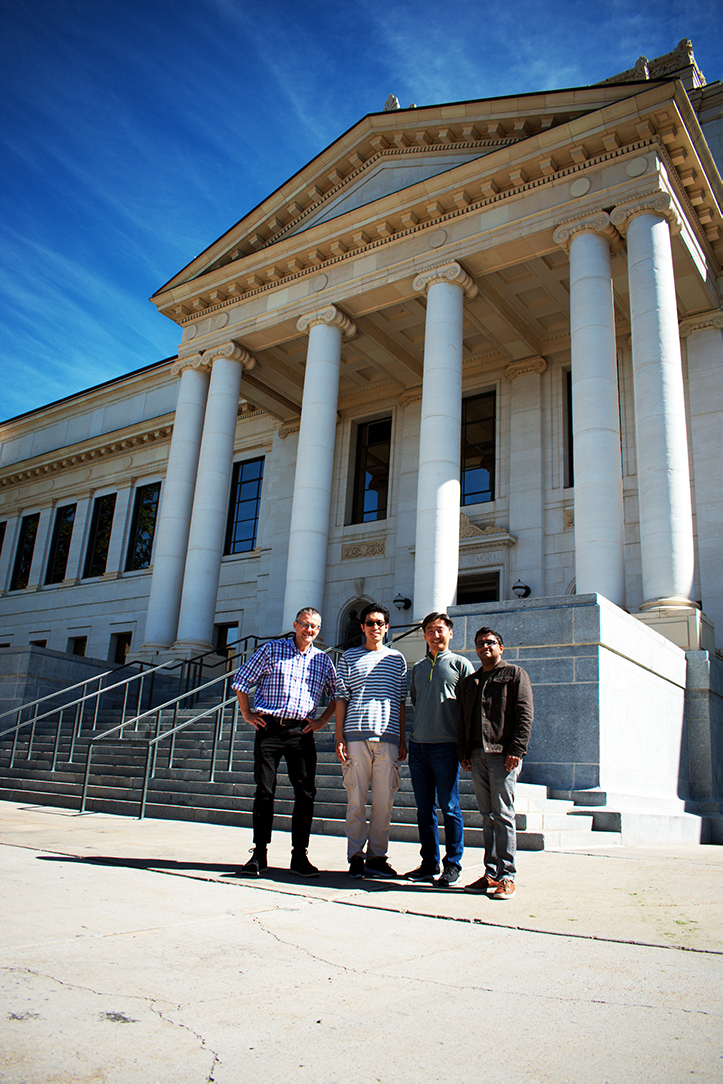Research Highlight: LIGO Scientific Collaboration
On August 23rd, 2019, Professors Keunhan Park, Stephan LeBohec, Vikram Deshpande, and Yue Zhao obtained a formal membership into the LIGO Scientific Collaboration (LSC). The LIGO Scientific Collaboration (LSC) is an international community of scientists focused on the direct detection of gravitational waves to study and explore the physics of gravity, gravitational wave science, and astronomical phenomena. This is the first LSC membership that has ever been granted in the University of Utah.
The University of Utah LIGO group consists of two teams: the theoretical physics subgroup (led by Yue Zhao) and the optics subgroup (with Vikram Deshpande, Keunhan Park, and Stephan LeBohec.)
We asked this newly instated LIGO team to share how the achieved about this highly prestigious membership.
What is a LIGO Scientific Collaboration membership?
By having a group of its professors obtain LSC membership, the University of Utah became part of one of the greatest ongoing scientific adventures. Membership gives us access to LIGO internal documents, as well as current analysis codes and communication channels. This membership will facilitate the development of ties and partnership to make our contribution to the project more efficient. With the membership, our group is recognized as one making significant contributions to the science investigated by the LIGO collaboration.
How will this type of membership impact both our University and Utah communities?
It makes the University of Utah part of the adventure, which is significant in itself. Practically, it provides undergraduate and graduate students with new areas of research to explore over a broad range of topics: astrophysics, gravitational wave, particle physics, material science, optics, electronics, computation. Undergraduate students are being trained to perform hands-on research and work in teams toward an important scientific problem.
In a year or so, we will be in a good position to develop a community outreach program conducted individually toward schools & local science clubs or organizations more formally through the channels maintained by the College of Science.
In addition, direct observation of propagating gravitational wave is only the beginning of the newly born field called gravitational wave astronomy. The LIGO collaboration is expected to continue making major scientific discoveries, which will both broaden and deepen our understanding of the universe. Being an active part of this collaboration by contributing it’s their scientific studies will drastically improve the research profile of the University of Utah.
What was the initial VP for Research seed grant project and how did it set your group on the path to acquiring this membership?
In total, our group obtained two VPR seed grants. One is for fundamental research, and the other for optics instrumentation. These grants had a twofold impact: first and most importantly it gave us the chance to get started on our research before defending our membership application. Thanks to the seed grant, the theory group was able to complete a study using LIGO data to look for dark photon dark matter. This nicely demonstrates that the theory group is fully committed to LIGO-related studies and is capable of carrying out promised work. Similarly, the optics group had made progresses in the development of a mirror coating testing technique that was sufficient to demonstrate the commitment of the experimental group to the LSC research program. The Seed Grants also demonstrated to the LSC that the Utah group is developing within a supportive research environment. By admitting our group of researchers within the collaboration, the LSC really admitted the University of Utah, and it is now much easier for other interested University of Utah researchers to join the collaboration.
What do each of you hope to accomplish in your future research?
Vikram, Keunhan, Stephan and their students are working on the design of mirrors to be used in gravitational wave detectors to improve their sensitivity. The detection of gravitational waves is achieved by recording tiny changes in the distance between mirrors separated by a few miles. A gravitational wave reveals itself by a brief variation of the distance at the level of 10-18m (that is one thousand times smaller than the nucleus of an atom, which is itself one million times smaller than an atom, which is one billion times smaller than this dot: “.”). This is amazing but we believe we can do even better. One limitation comes from the fact the mirrors vibrate because of thermal energy. The mirror coatings play an important role in this transfer of energy between heat and vibration. We are trying to engineer and identify coatings that will be less susceptible to this problem. We plan to do this by characterizing cryogenically cooled samples; this approach is doubly significant because future generations of gravitational wave interferometers will use cryogenically cooled mirrors for increased sensitivity. By improving the sensitivity of gravitational wave detectors, we will increase the volume of the universe that can be explored through gravitational waves.
Yue’s group works on several gravitational wave related theoretical topics. The goal of the group is to build a bridge between gravitational wave physics and particle physics, and to reveal the fundamental laws in nature. One of the biggest mysteries in our Universe is the identity of dark matter. It is widely accepted that dark matter exists in our Universe. The energy taken by dark matter is much larger than, about 5 times, that in baryonic sector of which stars and human beings are made. However, we have no idea on the mass of dark matter particles at all. It can be ultra-light, about 26 orders of magnitude smaller than an electron mass, or it can be extremely heavy, comparable to the mass of our Sun. Yue’s group study the possibility on utilizing LIGO gravitational wave detector to search for dark matter candidates on both extremes. Furthermore, the group also studies the gravitational waves produced at the very early time of the Universe. In general, people have very comprehensive understandings of the Universe one second after its creation. However, what happens before that one second remains largely unknown. Exotic phenomena, such as the production of cosmic strings or strong first order phase transitions, can naturally happen in many particle physics models and they would produce relic gravitational wave background. The LIGO gravitational wave detector provides one, often the only one, method to probe the existence of such processes happening during the earliest cosmological time. If observed, this will trigger revolutions on particle physics and significantly extend our knowledge of the fundamental laws of nature.


